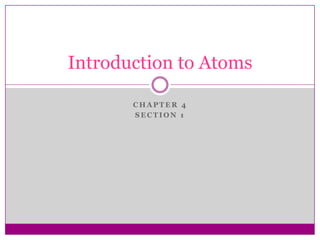
4.1
- 1. Introduction to Atoms CHAPTER 4 SECTION 1
- 2. History of Atom All atoms share the same basic structure During past 200 years, scientists have proposed different models. An atom is the smallest particle of an element. Atomic theory grew as a series of models that developed from experimental evidence. As more evidence was collected, the theory and models were revised.
- 3. Dalton’s Model Based on experiments, Dalton developed a theory of structure of matter 4 main concepts: All matter is composed of tiny, indivisible particles called atoms Atoms of each element are exactly alike Atoms of different elements have different masses Atoms of different elements can join to form compounds
- 5. Thomson’s Model End of 1800s Thomson discovered that atoms were not simple, solid spheres Atoms contained subatomic particles Very small, negatively charged Called them electrons
- 6. Discovery of the Electron In 1897, J.J. Thomson used a cathode ray tube to deduce the presence of a negatively charged particle: the electron
- 7. Modern Cathode Ray Tubes Television Computer Monitor Cathode ray tubes pass electricity through a gas that is contained at a very low pressure.
- 8. Thomson’s Model Also knew that atoms were electrically neutral Must contain enough positive charge to balance negative charge of electrons Developed model where electrons were stuck into a positively charged sphere Like chocolate chips in cookie dough
- 10. Rutherford’s Model By early 1900s, scientists knew that positive charge of atom comes from subatomic particles called protons A proton is a positive charged particle in the nucleus of an atom. 1911—Rutherford begins to test theory His experiments led him to believe that protons are concentrated in a small area at center of atom Called this area the nucleus
- 11. Rutherford’s Model Rutherford’s model describes an atom as mostly empty space, with a center nucleus that contains nearly all the mass Like the pit in a peach
- 12. Bohr’s Model Modified Rutherford’s model in 1913 Proposed that each electron has a certain amount of energy Helped electron move around nucleus Electrons move around nucleus in region called energy levels The energy level is the specific amount of energy an electron has. Energy levels surround nucleus in rings, like layers of onion
- 13. Bohr’s Model Has been called planetary model Energy levels occupied by electrons are like orbits of planets at different distances from the sun (nucleus)
- 14. Electron Cloud Model Model accepted today Electrons dart around in an energy level Rapid, random motion creates a “cloud” of negative charge around nucleus Electron cloud gives atom its size and shape
- 16. Findings Eugen Goldstein in 1886 observed what is now called the “proton” - particles with a positive charge, and a relative mass of 1 (or 1840 times that of an electron) 1932 – James Chadwick confirmed the existence of the “neutron” – a particle with no charge, but a mass nearly equal to a proton
- 17. Atomic Number Atoms are composed of identical protons, neutrons, and electrons How then are atoms of one element different from another element? Elements are different because they contain different numbers of PROTONS The “atomic number” of an element is the number of protons in the nucleus # protons in an atom = # electrons
- 18. Atomic Number Atomic number (Z) of an element is the number of protons in the nucleus of each atom of that element. Element # of protons Atomic # (Z) Carbon 6 6 Phosphorus 15 15 Gold 79 79
- 19. Mass Number Mass number is the number of protons and neutrons in the nucleus of an isotope: Mass # = p+ + n0 Nuclide p+ n0 e- Mass # Oxygen - 18 8 10 8 18 Arsenic - 75 33 42 33 75 Phosphorus - 31 15 16 15 31
- 20. The Complete Set-UP Contain the symbol of the element, the mass number and the atomic number. Superscript → Mass number Subscript → Atomic number X
- 21. Isotopes Dalton was wrong about all elements of the same type being identical Atoms of the same element can have different numbers of neutrons. Thus, different mass numbers. These are called isotopes.
- 22. Isotopes Frederick Soddy (1877-1956) proposed the idea of isotopes in 1912 Isotopes are atoms of the same element having different masses, due to varying numbers of neutrons. Soddy won the Nobel Prize in Chemistry in 1921 for his work with isotopes and radioactive materials.
- 23. Naming Isotopes We can also put the mass number after the name of the element: carbon-12 carbon-14 uranium-235
- 24. Isotopes are atoms of the same element having different masses, due to varying numbers of neutrons. Isotope Protons Electrons Neutrons Nucleus Hydrogen–1 (protium) 1 1 0 Hydrogen-2 (deuterium) 1 1 1 Hydrogen-3 1 1 2 (tritium)
- 25. Isotopes Elements occur in nature as mixtures of isotopes. Isotopes are atoms of the same element that differ in the number of neutrons.